 | ||
| Discover New Zealand, Home of Middle Earth | ||
 | ||
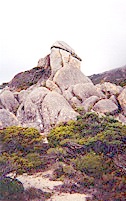 | We made camp in the same place the Fellowship did, among the rocks just west of the Redhorn Pass. The photo at the left shows the actual campsite and the rock from which Legolas spotted the crebain. The photo on the right shows the top of Caradhras and the deep ravine mentioned in the text. The mountain peak is not nearly covered with snow as it was then, but perhaps times are not now as severe as they were during the time of the Dark Lord. Near here the Fellowship was attacked by wolves, but we couldn't find the exact spot, if in fact there was only one. In any case, we decided to push on a little farther up the pass to see if we could find where the Fellowship had to stop and change their plans. | 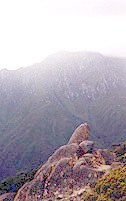 |
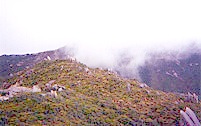 | I believe that the area shown on the left is the cliff mentioned in the text, but we could not find a path to or past it. It may be that the terrain has shifted (or been shifted!) somewhat and the path is no longer there. There is steam or fog coming from somewhere below, and after a little searching we found that it was issuing from a deep cleft or vent in the mountain. Could this be an opening such as the one from which Gandalf chased the Balrog? | 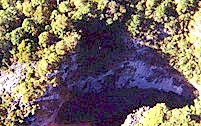 |
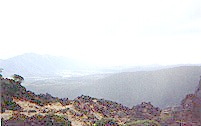 | Like the Fellowship, we had to turn back and find another way and leave the campsite behind. We decided to continue following their route, and so turned southwest to find the old dwarf path to the Sirannon and eventually to the Gate of Moria. We had gone about twenty miles or so when we came upon the flat, stony Sirannon river bed with the road running beside it. The road is broad and hard, obviously cut into the rock, but it follows the Sirannon eastward. | 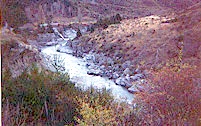 |
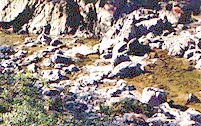 | The road itself is very old, broken in many places by debris which blocks the river and forces it to flow onto the road, so that the road is covered with water in many places even though it is otherwise well drained. As it goes eastward the trough through which it runs becomes deeper, and more steep, although the icy river, fed by many springs, rivulets and tributaries, becomes more quiet and flows much more slowly near its source at the Gate. | 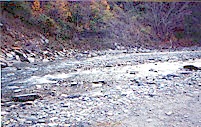 |
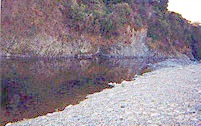 | We came to some broken stone steps and a dark, still lake fed by a small stream, and next to it a looming cliff, the Gate of Moria! The water here comes right up to the cliff face; there is no land between the water and the cliff nor any sign of a door or other opening. We shouted, "Mellon!" several times, but nothing happened. Climbing to the top of the cliff, we were surprised to find another (or perhaps the same) road continued over the top of the pass, the Dimrill Stair! | 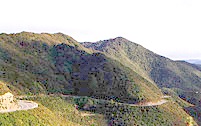 |
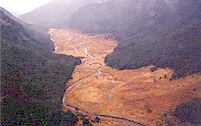 | The exit from Moria is most probably somewhat higher than the road, but it appeared to be someplace only someone in exceptionally good condition could reach, so neither Stefanie nor I attempted it. Like the dwarf road to Moria, the Dimrill Stair is cut into the solid rock of the mountain. Unlike the Sirannon, however, the Dimrill river valley is broad and flat, and the river meanders here and there over an endless ladder of short falls until it reaches Mirrormere. | 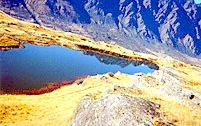 |
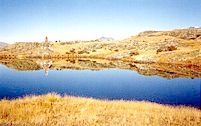 | Mirrormere, or Kheled-zaram ("lake of glass") in the language of the dwarves, is said to be always smooth, and it certainly was when we were there, as indicated in the two photos. The road here follows the western side of the lake; Durin's stone is clearly visible on the other side. Gimli is said to have examined the stone when he came upon it, but he would have had to cross the shallow Dimrill River at some point to do so, since the Stone is on the opposite side from Moria. | 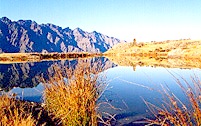 |
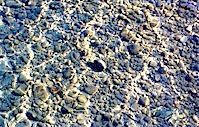 | We decided to test the claim that the faces of those who looked in it could not be seen, and it really is true! The water is so clear, there is no reflection, and one can only see the glittering, stony bottom. We did not see any stars, even though the daytime sky appears dark in the water. We had to bid farewell to Mirrormere and follow the Fellowship southeast to Lorien. When we reached the broad, green plain, we looked back to see the distant snowy cap of Celebdil. | 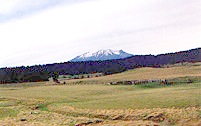 |
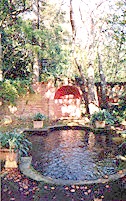 | Not far from Mirrormere we came to a little glade, obviously a ruin of some kind, containing a well of clear, cold water. It overflows into a small stream that runs glistening and gurgling down a steep rocky channel. The stream broadens out and becomes a swift river, fed by many small tributaries, as it ducks between and under overhanging bushes and trees. This is the Silverlode, or Celebrant, which flows through Lothlorien until it joins the mighty Anduin. There is a narrow green path along the river, not exactly a road but obviously cleared for easy travel, that follows the western bank of the river. It must have been easy for the Fellowship here to forget that the hobbits could not keep up with the others. | 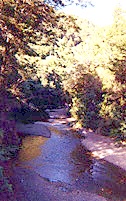 |
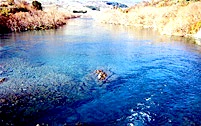 | The Silverlode leaps down a trough into the lower valley and then flows noisily along the open plain until it enters the Golden Wood. The water is very clear, and has the same non-reflecting quality as the waters in Mirrormere, although the bottom of shiny pebbles is somewhat more scoured than the quite waters of the mountain lake. We felt it was all right to disturb the surface to fill our canteens and take a little break, as the hobbits did, beside it. | 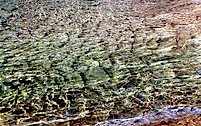 |
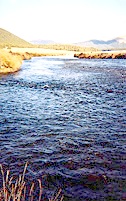 | Here the Silverlode is joined by another, smaller stream, possibly the Nimrodel. It flows over a bed of greenish stones, and plunges into a dell. At the bottom there is a level space with fir trees and some other trees and bushes we couldn't identify. Aragorn is said to have tended Frodo's and Sam's wounds in such a place, and we assumed that we had found the very spot. It does not look like a natural clearing at all, and appears to be well-tended without being overly manicured, the hallmark of elves. There is a stone pathway, laid without mortar, made from wonderfully flat stones that are still perfectly aligned. There are also some stone benches scattered about, definitely made by skilled (dwarf?) stonecutters. | 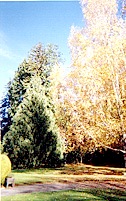 |
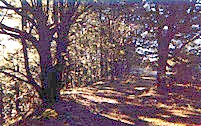 | The road here enters the woods, which are quiet and tranquil without being oppressive or gloomy. This is the "golden wood" of Lothlorien, so named because the trees here are actually golden, as shown in the waning sun on the right. There is a sense of expectation here, as if the woods are waiting for something, or perhaps remembering something or someone long gone. Since we didn't know exactly what path the Fellowship took through the woods, we decided to camp here. | 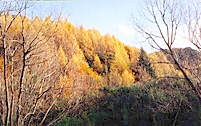 |
Click here to go to Day 8 * Click here to send us e-mail | ||